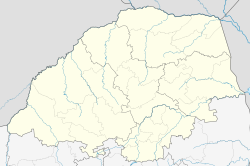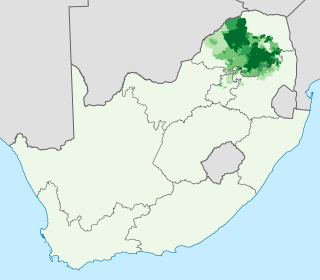
Sesotho sa Lebowa is a Sotho-Tswana language group spoken in the northeastern provinces of South Africa, most commonly in Mpumalanga, Gauteng and the Limpopo provinces. It is erroneously commonly referred to in its standardised form as Pedi or Sepedi and holds the status of an official language in South Africa.

Limpopo is the northernmost province of South Africa. It is named after the Limpopo River, which forms the province's western and northern borders. The capital and largest city in the province is Polokwane, while the provincial legislature is situated in Lebowakgomo.

Lebowa was a bantustan ("homeland") located in the Transvaal in northeastern South Africa. Seshego initially acted as Lebowa's capital while the purpose-built Lebowakgomo was being constructed. Granted internal self-government on 2 October 1972 and ruled for much of its existence by Cedric Phatudi, Lebowa was reincorporated into South Africa in 1994. It became part of the Limpopo province. The territory was not contiguous, being divided into two major and several minor portions.

The Sotho-Tswana, also known as the Sotho or Basotho, although the term is now closely associated with the Southern Sotho peoples are a meta-ethnicity of Southern Africa. They are a large and diverse group of people who speak Sotho-Tswana languages. The group is predominantly found in Botswana, Lesotho, South Africa, and the western part of Zambia. Smaller groups can also be found in Namibia and Zimbabwe.
Lebowakgomo is the seat of the Lepelle-Nkumpi Local Municipality and was the capital of the former Bantustan of Lebowa. Lebowakgomo lies 45 km (28 mi) southeast of the Limpopo capital of Polokwane. The majority of Lebowakgomo's inhabitants speak SePedi.
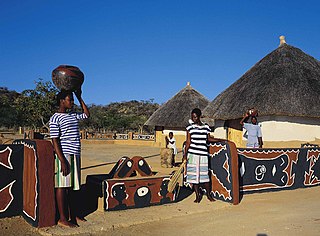
The Pedi or Bapedi, also known as the Sotho, Basotho, Northern Sotho, Basotho ba Lebowa, Transvaal Sotho, Marota, or Dikgoshi.
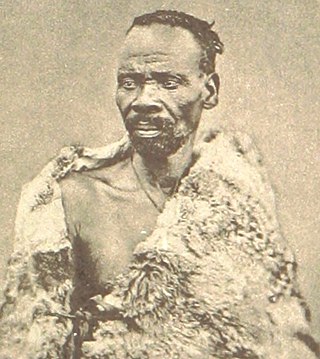
Sekhukhune I was the paramount King of the Marota, more commonly known as the Bapedi, from 21 September 1861 until his assassination on 13 August 1882 by his rival and half-brother, Mampuru II. As the Pedi paramount leader he was faced with political challenges from Voortrekkers, the independent South African Republic, the British Empire, and considerable social change caused by Christian missionaries.

Alexander Merensky was a German missionary, working in South Africa (Transvaal) from 1859 to 1892.
Green Farm is a village in the province of Limpopo in South Africa. The village is situated in the north east region of Limpopo province within the newly demarcated Collins Chabane Local Municipality. It used to be part of the Thulamela local municipality, Vhembe district. The village is located
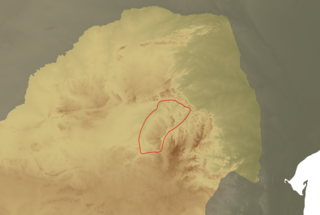
Sekhukhuneland or Sekukuniland is a natural region in north-east South Africa, located in the historical Transvaal zone, former Transvaal Province, also known as Bopedi. The region is named after the 19th-century King, Sekhukhune I.
Jane Furse is a town in the Sekhukhune District Municipality of the Limpopo province in South Africa, surrounded by the villages of Ga-Moretsele, Madibong, Marulaneng, Mamone, Mokwete and Riverside.
Praktiseer is a town in Sekhukhune District Municipality in the Limpopo province of South Africa.
Ga Riba is a village located in the Bushveld Complex in Fetakgomo Tubatse Local Municipality in the Limpopo province of South Africa.
Marulaneng is a village in the Sekhukhune District Municipality in the Limpopo Province, South Africa. Marulaneng falls within the administrative boundaries of the Makhuduthamaga Local Municipality.
Setumong is a large village in the Polokwane Local Municipality of the Capricorn District Municipality in the Limpopo province of South Africa. It is the capital of the Ga-Matlala tribal chieftaincy and headquarters the Bakone Traditional Council. It located about 48 km northwest of the city of Polokwane on the Matlala Road.
The Pulana, or Mapulana, are a low-veld ethnic group found in Bushbuckridge near Mpumalanga and Limpopo provinces. Their language is called Sepulana and is considered a dialect of the [[Northern Sotho language] group. although it is a northern sotho dialect it also hugely influenced by Xitsonga,Swati,Afrikaans,English. and setswana
Makotopong is a village located 30 km outside the town of Polokwane within the province of Limpopo in South Africa. Makotopong falls under the Polokwane Local Municipality.
Mampuru II was a king of the Pedi people in southern Africa. Mampuru was a son of the elder brother of Sekwati and claimed he had been designated as his successor.
Peter Mampogoane Nchabeleng was a South African trade unionist and anti-apartheid activist who died in police detention in the Lebowa bantustan in April 1986. At the time of his death, he was the inaugural chairperson of the United Democratic Front in the Northern Transvaal and head of the underground African National Congress (ANC) in the same region.

Johannes August Winter was a German Lutheran missionary for the Berlin Missionary Society (BMS) who played an important role in the formation of the Lutheran Bapedi Church in South Africa at the turn of the 19th century, against a backdrop of competing political and economic power struggles between British, Afrikaner and native tribal interests.
